An official website of the United States government
 United States Department of Labor
United States Department of Labor
Set up, operate, or tend machines, such as glass-forming machines, plodder machines, and tuber machines, to shape and form products such as glassware, food, rubber, soap, brick, tile, clay, wax, tobacco, or cosmetics. Excludes "Shoe Machine Operators and Tenders" (51-6042) and "Paper Goods Machine Setters, Operators, and Tenders" (51-9196).
Employment estimate and mean wage estimates for Extruding, Forming, Pressing, and Compacting Machine Setters, Operators, and Tenders:
| Employment (1) | Employment RSE (3) |
Mean hourly wage |
Mean annual wage (2) |
Wage RSE (3) |
|---|---|---|---|---|
| 63,730 | 2.4 % | $ 18.48 | $ 38,440 | 0.7 % |
Percentile wage estimates for Extruding, Forming, Pressing, and Compacting Machine Setters, Operators, and Tenders:
| Percentile | 10% | 25% | 50% (Median) |
75% | 90% |
|---|---|---|---|---|---|
| Hourly Wage | $ 12.42 | $ 14.32 | $ 17.58 | $ 22.12 | $ 26.58 |
| Annual Wage (2) | $ 25,830 | $ 29,780 | $ 36,560 | $ 46,010 | $ 55,300 |
Industries with the highest published employment and wages for Extruding, Forming, Pressing, and Compacting Machine Setters, Operators, and Tenders are provided. For a list of all industries with employment in Extruding, Forming, Pressing, and Compacting Machine Setters, Operators, and Tenders, see the Create Customized Tables function.
Industries with the highest levels of employment in Extruding, Forming, Pressing, and Compacting Machine Setters, Operators, and Tenders:
| Industry | Employment (1) | Percent of industry employment | Hourly mean wage | Annual mean wage (2) |
|---|---|---|---|---|
| Nonmetallic Mineral Product Manufacturing | 14,110 | 3.52 | $ 19.06 | $ 39,640 |
| Rubber Product Manufacturing | 13,190 | 10.89 | $ 18.09 | $ 37,620 |
| Plastics Product Manufacturing | 8,700 | 1.55 | $ 17.32 | $ 36,030 |
| Pharmaceutical and Medicine Manufacturing | 3,790 | 1.27 | $ 19.80 | $ 41,180 |
| Employment Services | 2,920 | 0.09 | $ 15.28 | $ 31,780 |
Industries with the highest concentration of employment in Extruding, Forming, Pressing, and Compacting Machine Setters, Operators, and Tenders:
| Industry | Employment (1) | Percent of industry employment | Hourly mean wage | Annual mean wage (2) |
|---|---|---|---|---|
| Rubber Product Manufacturing | 13,190 | 10.89 | $ 18.09 | $ 37,620 |
| Tobacco Manufacturing | 560 | 5.71 | $ 22.50 | $ 46,810 |
| Nonmetallic Mineral Product Manufacturing | 14,110 | 3.52 | $ 19.06 | $ 39,640 |
| Animal Food Manufacturing | 1,360 | 2.11 | $ 17.35 | $ 36,080 |
| Plastics Product Manufacturing | 8,700 | 1.55 | $ 17.32 | $ 36,030 |
Top paying industries for Extruding, Forming, Pressing, and Compacting Machine Setters, Operators, and Tenders:
| Industry | Employment (1) | Percent of industry employment | Hourly mean wage | Annual mean wage (2) |
|---|---|---|---|---|
| Aerospace Product and Parts Manufacturing | 70 | 0.01 | $ 26.76 | $ 55,670 |
| Pulp, Paper, and Paperboard Mills | 1,140 | 1.25 | $ 24.61 | $ 51,190 |
| Petroleum and Coal Products Manufacturing | 150 | 0.14 | $ 24.30 | $ 50,540 |
| Tobacco Manufacturing | 560 | 5.71 | $ 22.50 | $ 46,810 |
| Nonferrous Metal (except Aluminum) Production and Processing | 200 | 0.34 | $ 21.84 | $ 45,430 |
States and areas with the highest published employment, location quotients, and wages for Extruding, Forming, Pressing, and Compacting Machine Setters, Operators, and Tenders are provided. For a list of all areas with employment in Extruding, Forming, Pressing, and Compacting Machine Setters, Operators, and Tenders, see the Create Customized Tables function.
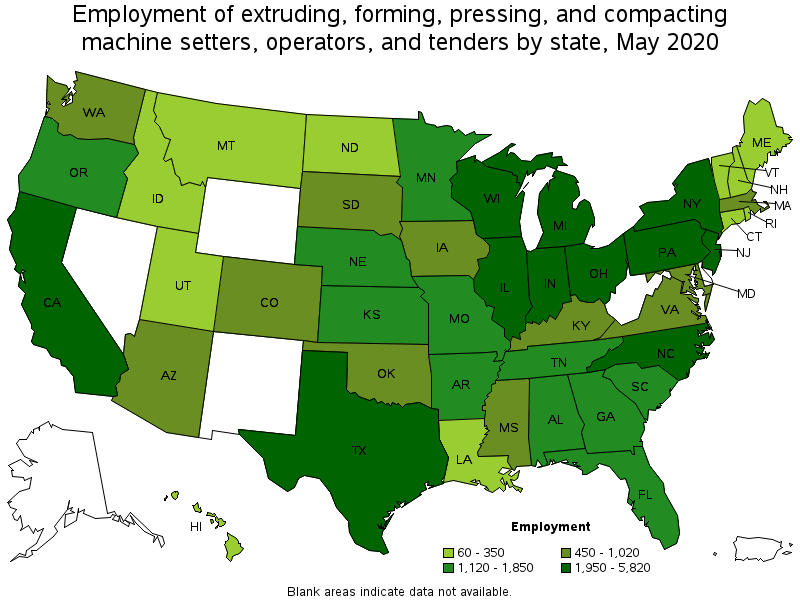
States with the highest employment level in Extruding, Forming, Pressing, and Compacting Machine Setters, Operators, and Tenders:
| State | Employment (1) | Employment per thousand jobs | Location quotient (9) | Hourly mean wage | Annual mean wage (2) |
|---|---|---|---|---|---|
| Texas | 5,820 | 0.48 | 1.05 | $ 15.62 | $ 32,490 |
| Ohio | 5,750 | 1.12 | 2.44 | $ 17.36 | $ 36,100 |
| California | 4,740 | 0.29 | 0.63 | $ 18.48 | $ 38,430 |
| New York | 3,020 | 0.35 | 0.76 | $ 21.32 | $ 44,350 |
| Indiana | 2,930 | 1.01 | 2.19 | $ 18.31 | $ 38,090 |
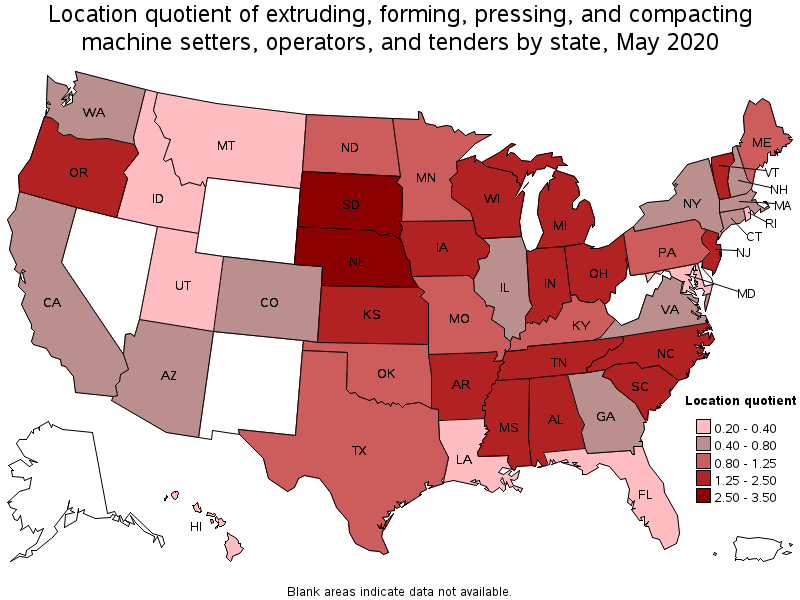
States with the highest concentration of jobs and location quotients in Extruding, Forming, Pressing, and Compacting Machine Setters, Operators, and Tenders:
| State | Employment (1) | Employment per thousand jobs | Location quotient (9) | Hourly mean wage | Annual mean wage (2) |
|---|---|---|---|---|---|
| Nebraska | 1,400 | 1.49 | 3.24 | $ 20.78 | $ 43,220 |
| South Dakota | 600 | 1.46 | 3.19 | $ 17.15 | $ 35,660 |
| Ohio | 5,750 | 1.12 | 2.44 | $ 17.36 | $ 36,100 |
| Indiana | 2,930 | 1.01 | 2.19 | $ 18.31 | $ 38,090 |
| Arkansas | 1,160 | 0.98 | 2.15 | $ 19.66 | $ 40,890 |
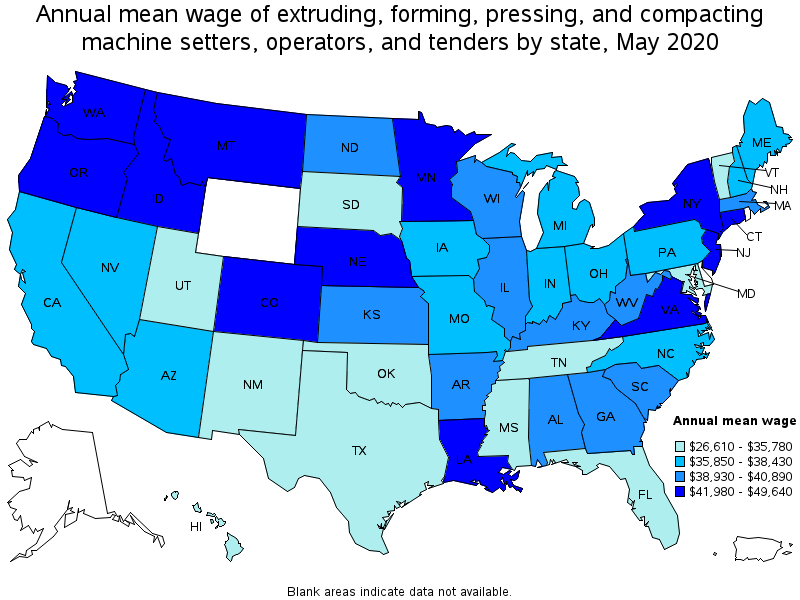
Top paying states for Extruding, Forming, Pressing, and Compacting Machine Setters, Operators, and Tenders:
| State | Employment (1) | Employment per thousand jobs | Location quotient (9) | Hourly mean wage | Annual mean wage (2) |
|---|---|---|---|---|---|
| Montana | 60 | 0.13 | 0.29 | $ 23.86 | $ 49,640 |
| Idaho | 110 | 0.15 | 0.32 | $ 23.70 | $ 49,290 |
| Colorado | 510 | 0.20 | 0.43 | $ 23.14 | $ 48,140 |
| Connecticut | 350 | 0.23 | 0.50 | $ 22.44 | $ 46,670 |
| Washington | 720 | 0.23 | 0.49 | $ 21.39 | $ 44,480 |
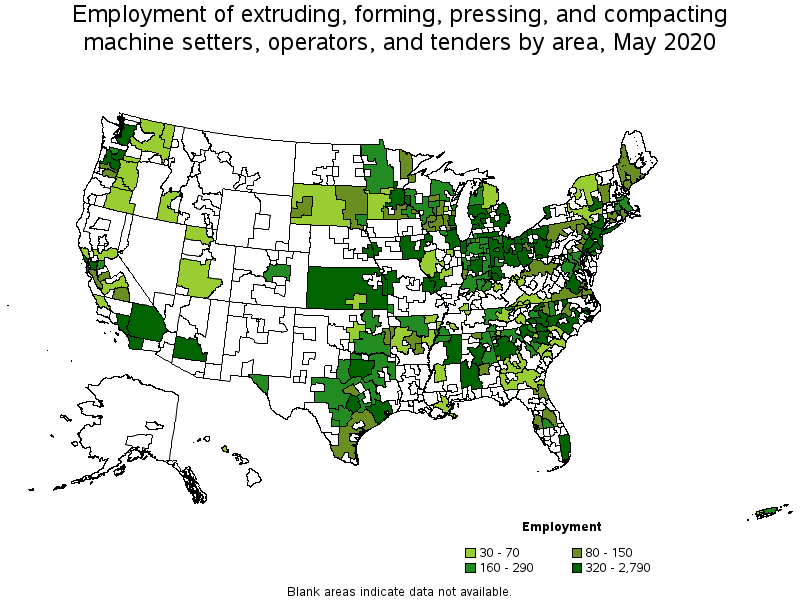
Metropolitan areas with the highest employment level in Extruding, Forming, Pressing, and Compacting Machine Setters, Operators, and Tenders:
| Metropolitan area | Employment (1) | Employment per thousand jobs | Location quotient (9) | Hourly mean wage | Annual mean wage (2) |
|---|---|---|---|---|---|
| New York-Newark-Jersey City, NY-NJ-PA | 2,790 | 0.32 | 0.69 | $ 20.64 | $ 42,940 |
| Los Angeles-Long Beach-Anaheim, CA | 2,010 | 0.35 | 0.75 | $ 18.05 | $ 37,540 |
| Dallas-Fort Worth-Arlington, TX | 1,940 | 0.54 | 1.18 | $ 14.94 | $ 31,070 |
| Chicago-Naperville-Elgin, IL-IN-WI | 1,630 | 0.37 | 0.82 | $ 17.64 | $ 36,700 |
| Houston-The Woodlands-Sugar Land, TX | 1,460 | 0.49 | 1.07 | $ 15.52 | $ 32,280 |
| Minneapolis-St. Paul-Bloomington, MN-WI | 870 | 0.47 | 1.03 | $ 20.71 | $ 43,090 |
| Kansas City, MO-KS | 840 | 0.82 | 1.78 | $ 20.12 | $ 41,850 |
| Cleveland-Elyria, OH | 760 | 0.78 | 1.69 | $ 16.19 | $ 33,680 |
| Charlotte-Concord-Gastonia, NC-SC | 760 | 0.63 | 1.37 | $ 17.68 | $ 36,780 |
| Albany-Schenectady-Troy, NY | 750 | 1.78 | 3.88 | $ 26.16 | $ 54,410 |
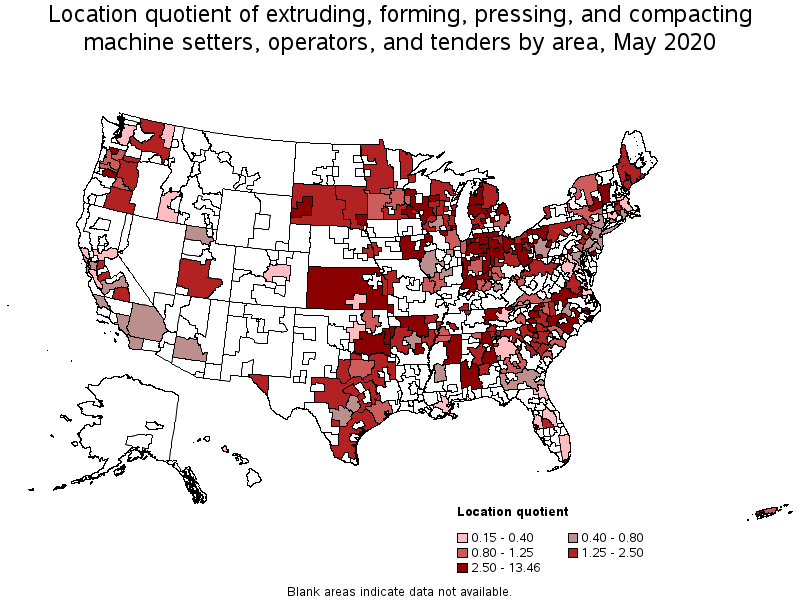
Metropolitan areas with the highest concentration of jobs and location quotients in Extruding, Forming, Pressing, and Compacting Machine Setters, Operators, and Tenders:
| Metropolitan area | Employment (1) | Employment per thousand jobs | Location quotient (9) | Hourly mean wage | Annual mean wage (2) |
|---|---|---|---|---|---|
| Lima, OH | 280 | 6.08 | 13.27 | $ 19.02 | $ 39,560 |
| Longview, WA | 200 | 5.46 | 11.91 | $ 25.56 | $ 53,160 |
| Michigan City-La Porte, IN | 190 | 4.81 | 10.50 | $ 18.15 | $ 37,750 |
| Pine Bluff, AR | 130 | 4.65 | 10.15 | (8) | (8) |
| Vineland-Bridgeton, NJ | 260 | 4.58 | 10.00 | $ 25.56 | $ 53,170 |
| Gettysburg, PA | 100 | 3.41 | 7.43 | $ 18.36 | $ 38,200 |
| Midland, MI | 90 | 2.77 | 6.06 | $ 13.40 | $ 27,870 |
| Albany, OR | 110 | 2.54 | 5.54 | $ 21.89 | $ 45,530 |
| Joplin, MO | 170 | 2.26 | 4.94 | $ 19.04 | $ 39,600 |
| Rockford, IL | 290 | 2.18 | 4.76 | (8) | (8) |
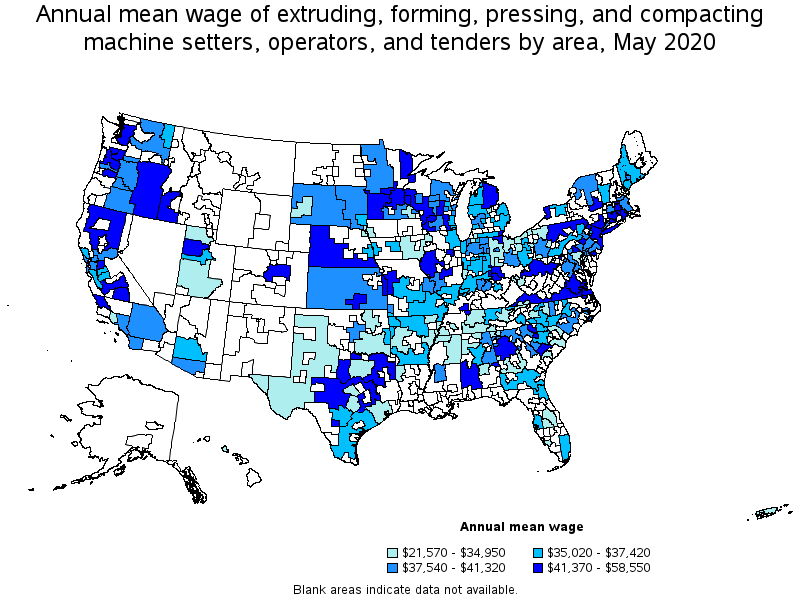
Top paying metropolitan areas for Extruding, Forming, Pressing, and Compacting Machine Setters, Operators, and Tenders:
| Metropolitan area | Employment (1) | Employment per thousand jobs | Location quotient (9) | Hourly mean wage | Annual mean wage (2) |
|---|---|---|---|---|---|
| New Haven, CT | 90 | 0.32 | 0.71 | $ 28.15 | $ 58,550 |
| Albany-Schenectady-Troy, NY | 750 | 1.78 | 3.88 | $ 26.16 | $ 54,410 |
| Vineland-Bridgeton, NJ | 260 | 4.58 | 10.00 | $ 25.56 | $ 53,170 |
| Longview, WA | 200 | 5.46 | 11.91 | $ 25.56 | $ 53,160 |
| Spartanburg, SC | 200 | 1.31 | 2.85 | $ 25.04 | $ 52,080 |
| Denver-Aurora-Lakewood, CO | 260 | 0.18 | 0.38 | $ 24.52 | $ 51,010 |
| Reading, PA | 100 | 0.58 | 1.28 | $ 23.77 | $ 49,440 |
| Albany, OR | 110 | 2.54 | 5.54 | $ 21.89 | $ 45,530 |
| Auburn-Opelika, AL | (8) | (8) | (8) | $ 21.83 | $ 45,410 |
| Stockton-Lodi, CA | 160 | 0.64 | 1.39 | $ 21.80 | $ 45,340 |
Nonmetropolitan areas with the highest employment in Extruding, Forming, Pressing, and Compacting Machine Setters, Operators, and Tenders:
| Nonmetropolitan area | Employment (1) | Employment per thousand jobs | Location quotient (9) | Hourly mean wage | Annual mean wage (2) |
|---|---|---|---|---|---|
| North Northeastern Ohio nonmetropolitan area (noncontiguous) | 940 | 3.03 | 6.61 | $ 16.28 | $ 33,850 |
| Eastern Ohio nonmetropolitan area | 720 | 5.69 | 12.41 | $ 16.88 | $ 35,110 |
| Northeast Mississippi nonmetropolitan area | 560 | 2.51 | 5.47 | $ 15.57 | $ 32,380 |
| Kansas nonmetropolitan area | 560 | 1.48 | 3.23 | $ 18.48 | $ 38,440 |
| Piedmont North Carolina nonmetropolitan area | 550 | 2.26 | 4.93 | $ 17.34 | $ 36,070 |
Nonmetropolitan areas with the highest concentration of jobs and location quotients in Extruding, Forming, Pressing, and Compacting Machine Setters, Operators, and Tenders:
| Nonmetropolitan area | Employment (1) | Employment per thousand jobs | Location quotient (9) | Hourly mean wage | Annual mean wage (2) |
|---|---|---|---|---|---|
| Southwest Alabama nonmetropolitan area | 400 | 6.16 | 13.46 | $ 23.88 | $ 49,680 |
| Eastern Ohio nonmetropolitan area | 720 | 5.69 | 12.41 | $ 16.88 | $ 35,110 |
| North Northeastern Ohio nonmetropolitan area (noncontiguous) | 940 | 3.03 | 6.61 | $ 16.28 | $ 33,850 |
| Northeast Mississippi nonmetropolitan area | 560 | 2.51 | 5.47 | $ 15.57 | $ 32,380 |
| Western Pennsylvania nonmetropolitan area | 320 | 2.28 | 4.97 | $ 14.46 | $ 30,070 |
Top paying nonmetropolitan areas for Extruding, Forming, Pressing, and Compacting Machine Setters, Operators, and Tenders:
| Nonmetropolitan area | Employment (1) | Employment per thousand jobs | Location quotient (9) | Hourly mean wage | Annual mean wage (2) |
|---|---|---|---|---|---|
| Northern Pennsylvania nonmetropolitan area | 120 | 0.84 | 1.84 | $ 25.36 | $ 52,760 |
| North Valley-Northern Mountains Region of California nonmetropolitan area | (8) | (8) | (8) | $ 24.61 | $ 51,180 |
| Southwest Alabama nonmetropolitan area | 400 | 6.16 | 13.46 | $ 23.88 | $ 49,680 |
| South Nebraska nonmetropolitan area | (8) | (8) | (8) | $ 23.28 | $ 48,420 |
| Southwest Minnesota nonmetropolitan area | 50 | 0.43 | 0.94 | $ 22.88 | $ 47,590 |
These estimates are calculated with data collected from employers in all industry sectors, all metropolitan and nonmetropolitan areas, and all states and the District of Columbia. The top employment and wage figures are provided above. The complete list is available in the downloadable XLS files.
The percentile wage estimate is the value of a wage below which a certain percent of workers fall. The median wage is the 50th percentile wage estimate—50 percent of workers earn less than the median and 50 percent of workers earn more than the median. More about percentile wages.
(1) Estimates for detailed occupations do not sum to the totals because the totals include occupations not shown separately. Estimates do not include self-employed workers.
(2) Annual wages have been calculated by multiplying the hourly mean wage by a "year-round, full-time" hours figure of 2,080 hours; for those occupations where there is not an hourly wage published, the annual wage has been directly calculated from the reported survey data.
(3) The relative standard error (RSE) is a measure of the reliability of a survey statistic. The smaller the relative standard error, the more precise the estimate.
(8) Estimate not released.
(9) The location quotient is the ratio of the area concentration of occupational employment to the national average concentration. A location quotient greater than one indicates the occupation has a higher share of employment than average, and a location quotient less than one indicates the occupation is less prevalent in the area than average.
Other OEWS estimates and related information:
May 2020 National Occupational Employment and Wage Estimates
May 2020 State Occupational Employment and Wage Estimates
May 2020 Metropolitan and Nonmetropolitan Area Occupational Employment and Wage Estimates
May 2020 National Industry-Specific Occupational Employment and Wage Estimates
Last Modified Date: March 31, 2021